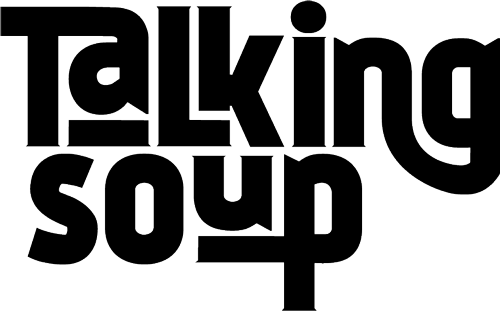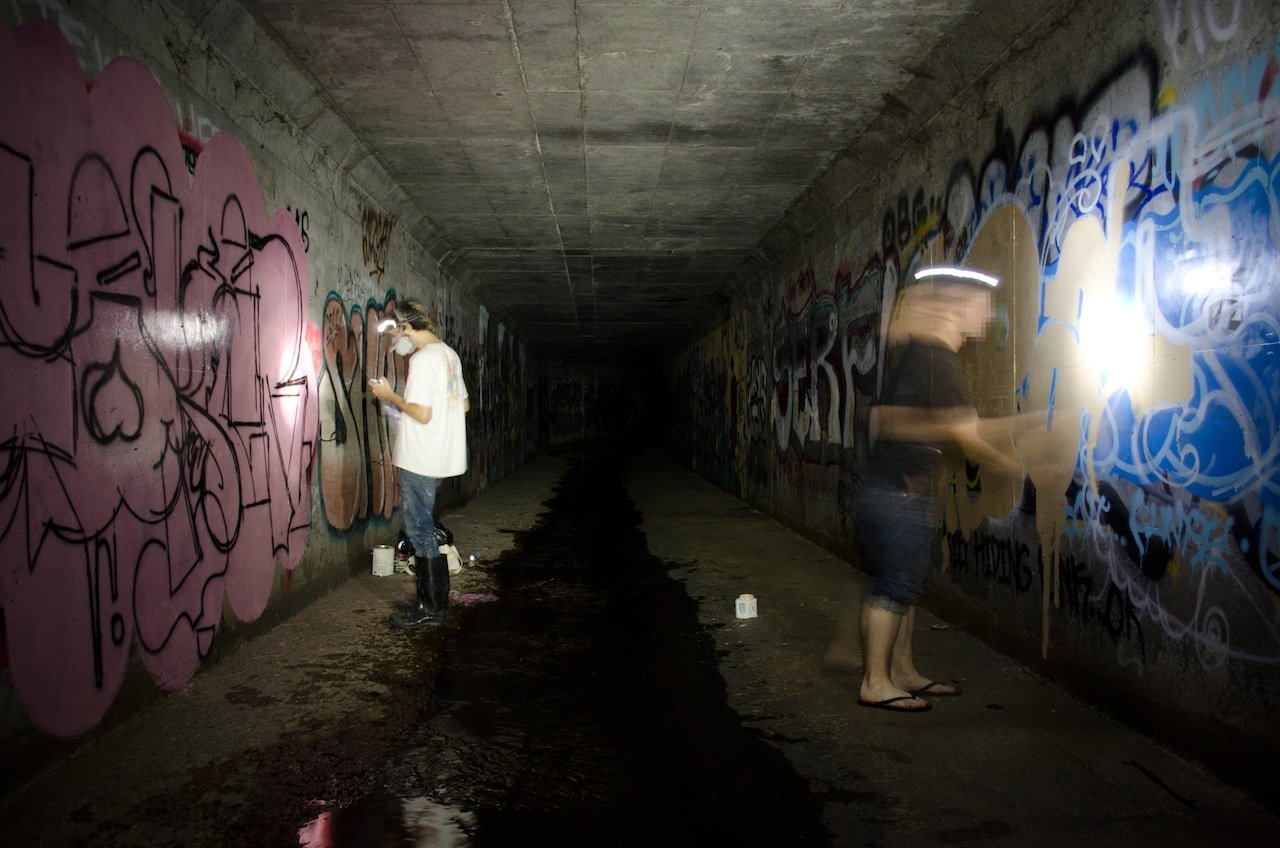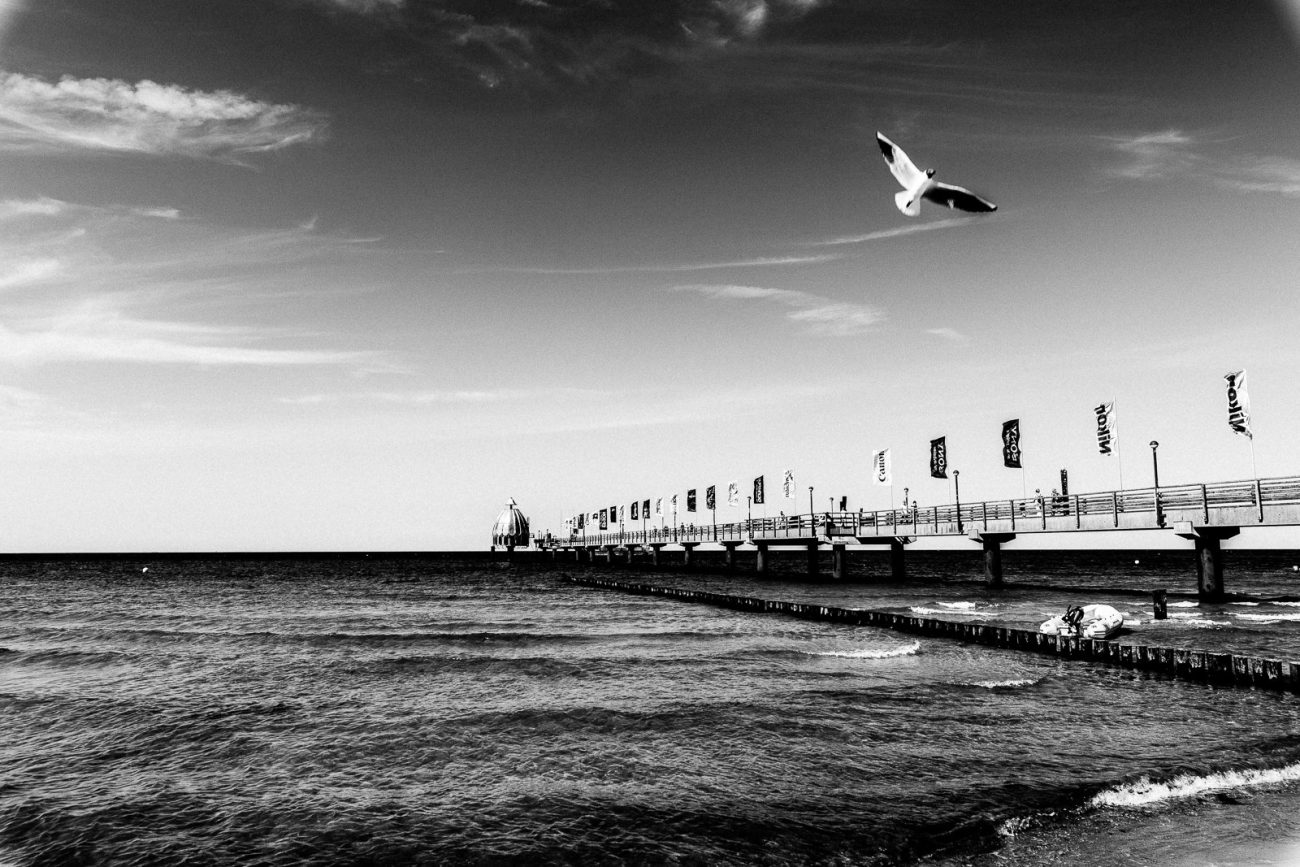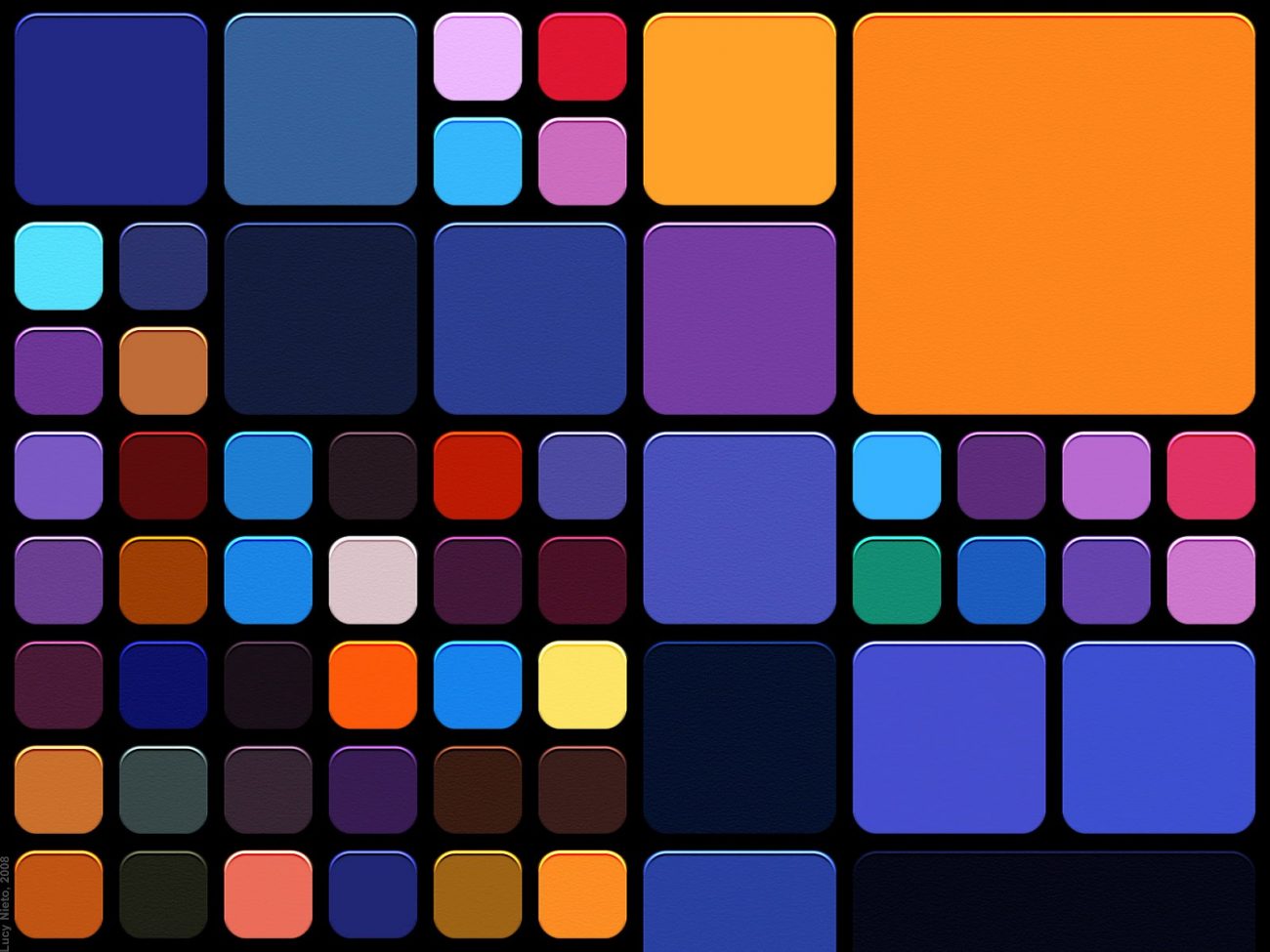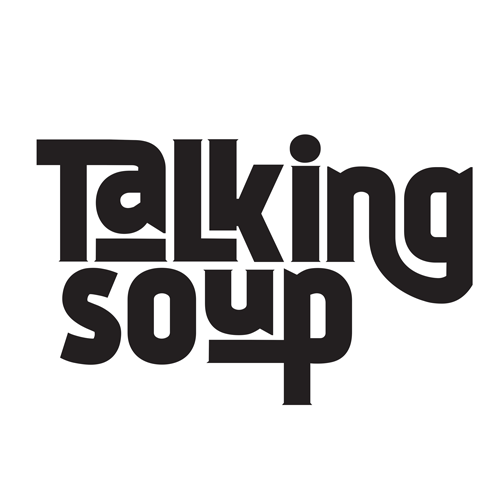From the streets of Oakland, CA, writer and activist Joseph Meehan takes a tour through the city’s underground graffiti-art scene. All photographs courtesy of Jessie Hoye
Through a hole in a chain-link fence with a forest-green vinyl coating lies the entrance to a waterway that runs underneath the Fruitvale neighborhood of Oakland, California. Down the slope of a small hill which leads to a man-made concrete creek bed there is a wall of ivy. Goker, a traveling graffiti artist currently based in Oakland, having already stopped to put on his galoshes, reaches into the middle of the sheet of waxy, green ivy leaves and pulls it back to reveal the wide mouth of a long tunnel into which the water from the creek trickles. He steps through and holds the makeshift door open for fellow Oakland-based artist Upae. His flip-flops flip and flop in the shallow water in counterpoint to Goker’s galoshes. Both will fare better than my sneakers. Through the ivy, the walls of the tunnel are painted in vivid combinations of blue, green, yellow and orange; green, red, and sky blue; orange and tan; teal, black, orange and blue. Each combination of outlines, fills and accents compose a graffiti artist’s handle.

Oakland is a city divided on graffiti. In the last five years a proliferation of street art, in particular graffiti, has occurred. Driving north on 880 toward downtown Oakland from the airport affords an excellent example of the street art that covers significant public property square footage. The walls and buildings and highway dividers and overpass supports in the stretch between 16th Avenue and 5th Avenue are covered with graffiti. Public property especially is hit with graffiti of all types, but privately-owned businesses are fair game as well. The city spends up to a million dollars per year on graffiti clean-up and abatement. Despite the large expenditures, the city doesn’t help private businesses with the removal of graffiti and in fact will fine businesses for blight if the graffiti is left for more than thirty days.
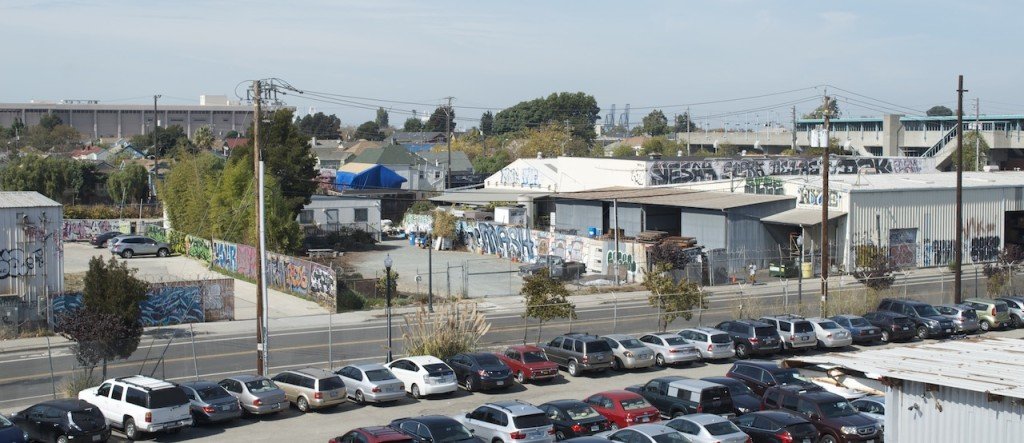
Not everyone sees graffiti as blight. Several organizations and a few individuals organize the legal painting of large murals on blank walls in the city to discourage artists from tagging the empty walls graffiti writers see as blank canvases. The larger murals tend to garner more respect and will not, for the most part, be tagged over. Some business owners however see the artists’ promise to stop the tagging as extortion to let their businesses be painted on or suffer the consequences, but many within the community embrace the murals for their beauty and cultural context.
Through the curtain of ivy, Goker and Upae look for a spot to paint on the walls among the other graffiti. Down in the tunnel artists can take their time and create complex compositions full of color and detail and polish. Most of the more complex and beautiful pieces stand the test of time; the lifespan of the artwork on these walls is a testament to respect for the piece and respect for the artist. Shrooms, another Bay Area graffiti artist who passed away recently, has a piece in the tunnel from 2010 that likely won’t be covered up for years to come. Some of the larger works have small, quickly-done tags called throw-ups on top of them. Others, with no respect for what came before, have already defaced better work than their own. The throw ups don’t deserve to live on here in the tunnel. They deserve to be painted over.

Upae chooses a spot on the wall where a larger and arguably better piece has two throw-ups on top of it: bubble letters with a simple black outline and red fill cover up a multi-faceted piece which must have taken hours to paint. The politics aren’t immediately obvious. Maybe there is a longstanding feud between the two previous artists, maybe there was something inherently offensive or crappy about the larger piece underneath. Either way, Upae decides this is his spot now. Goker continues walking up and down the dark tunnel trying to find the right spot. He eventually decides on one directly across from Upae, right next to the Shrooms piece.
Goker starts with a background of a solid color which covers the graffiti he will paint over. Upae begins with an outline that he will fill in as he paints. Unexpectedly to me and, I suspect, most of the uninitiated, they begin to paint the wall with twelve inch rollers. They paint deftly with the short-handled implements curves and lines and shapes that all form the background for the piece.

They paint with sureness in their hand and contentment in their visage. This looks like art, this looks like a creative process, this looks like it takes effort and skill and thoughtful execution and immaculate presentation, and so what difference does it really make if the walls in this underground waterway are covered in paint? It could be argued that the paintings beautify the otherwise drab concrete walls. There are plenty of places in Oakland like the tunnel we are in today: secluded, frequented only by graffiti artists presumably, and way off of the public right-of-way.
But then again, as Upae recalls what another graffiti writer said to him in the past, some have a much different ethos: “Fuck art. I’m not an artist. I’m a vandal.”
Upae freestyles, outlining and filling in the letters from memory as well as improvisation. Inspired by the patterns he encounters in a part-time furniture store job, Upae adds some paisley flair to his piece. On the other hand, when Goker is ready to start the outline of his letters he pulls out his phone to study a drawing he’s done previously. Both Goker and Upae draw and illustrate as well as paint graffiti. Goker looks to the drawing on his phone for cues on linework and accents. Upae considers the graffiti an extension of his other artistic pursuits – one that, due to its illicit nature, is often less polished.
Goker paints quietly, focused on his work and hardly looking up. Upae, unlike Goker, loves to talk while he works, and we talk about a range of subjects which includes Rashida Jones, Adventure Time, Calvin & Hobbes, graffiti, past jobs and other graffiti artists.

The pieces are nearing the end. I can tell because they begin to look like polished, finished pieces of work. The linework has been touched up, the fill is uniform, the accents and highlights and backsplashes are coming together. When asked how he knows when he’s done, Upae says, as many other artists say of their respective creative pursuits, it is just a matter of feeling. He relates you can continue messing with a piece forever – touching up lines where the paint has dripped, filling in the paint to a uniform thickness and color, adding this or that or the other – but at a certain point you have to know when to leave it alone. Adding in too much can ruin the piece, and possibly take it to a place you can’t recover from. Like all creative pursuits, there’s an element of knowing when the piece is done versus trying to make it perfect.
About fifteen minutes apart from each other Goker and Upae decide the pieces are done. They pack up their paint and Goker pulls out a small point-and-shoot digital camera to take some pictures of both pieces.

As I step into the retro diner atmosphere at Rudy’s one week later, Upae is already sitting down at a table amidst the other diners. I wonder whether or not he’s going to be comfortable talking to me about his illegal graffiti work among the other people, and he seems a tad bit wary throughout our conversation, but he patiently fields all of my questions and talks at length about his art.
A healthy sense of mischief is not the majority of why Upae writes graffiti, but it is definitely part of the reason. When I ask him what roots graffiti has in civil disobedience, he asks me: “What came first? The man writing on the wall or the privatization of the wall?” He goes on to define graffiti as the “expression of an identity or an idea through an identity on a surface without permission,” stressing in his inflection the ‘without permission’ part.
What is the hardest work about writing graffiti? “Everything about it besides the painting” Upae says with a strong laugh. “The walking, climbing, carrying, the staying up late, the running. It starts as a trickle but turns into a waterfall pretty quickly.
He cites a rumor, heard third-hand, that a lot of the money from the waning war on drugs is going to be pipelined into graffiti abatement and removal, for a reason things are beginning to heat up for graffiti artists in Oakland and around the country. I couldn’t confirm this through my own research. But it doesn’t matter anyway. In Upae’s view, “The world’s fucked, and I’m just going to keep on painting.”
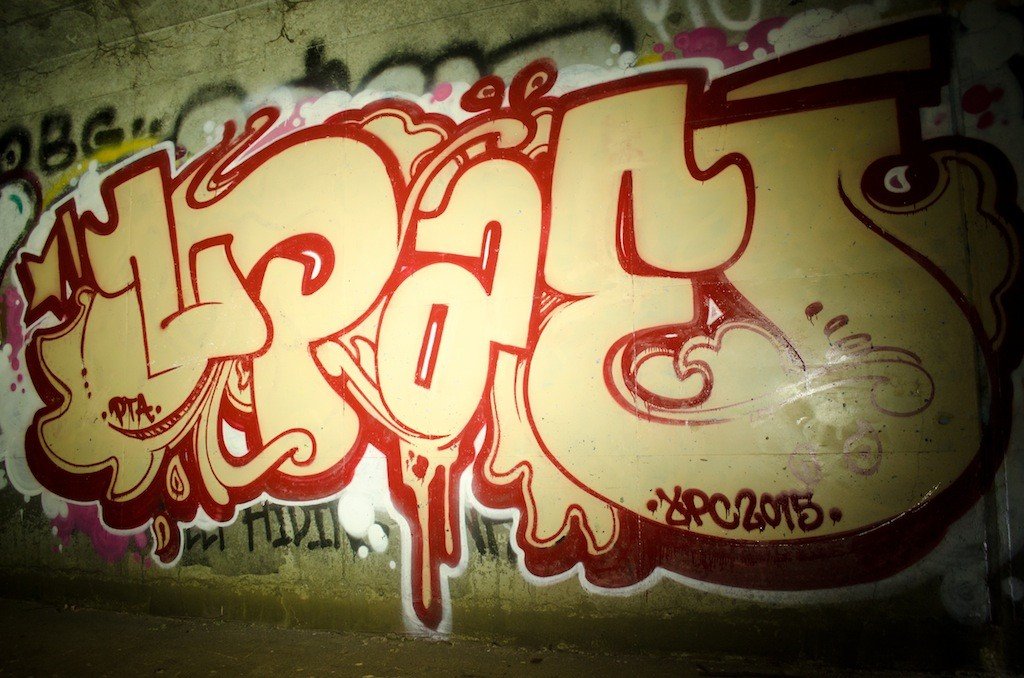
All photographs courtesy of Jessie Hoye who can be followed at jessiejaninephotography.com
Joseph Meehan is a writer who lives in Oakland, CA. He enjoys reading, writing, hiking, gardening and cooking. Along with his girlfriend and his dog, he can often be found hiking throughout the greater Bay Area.
